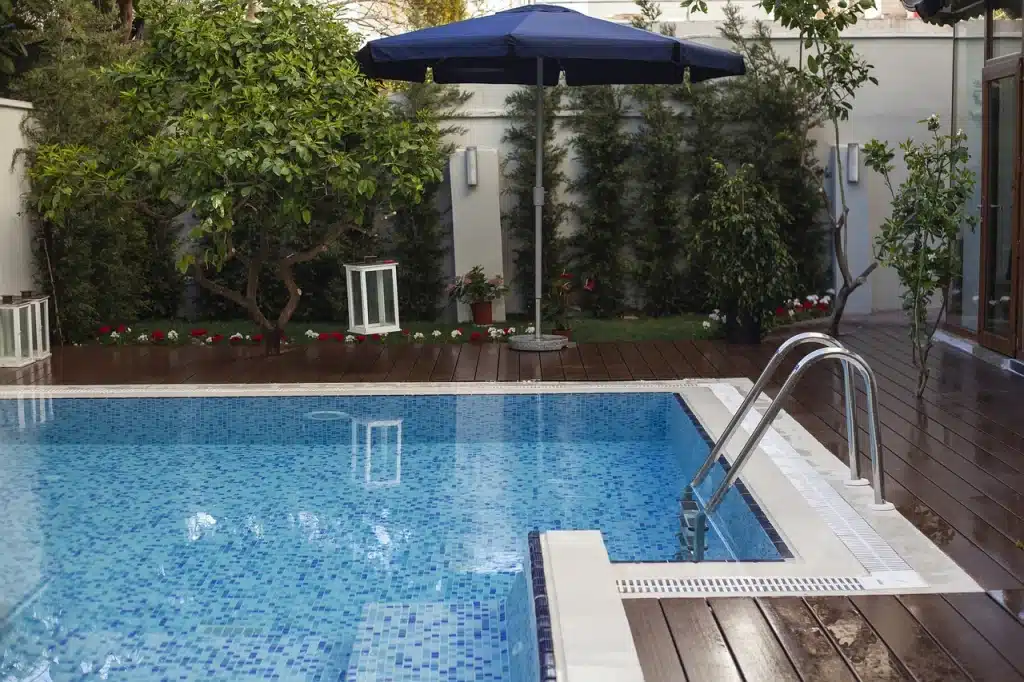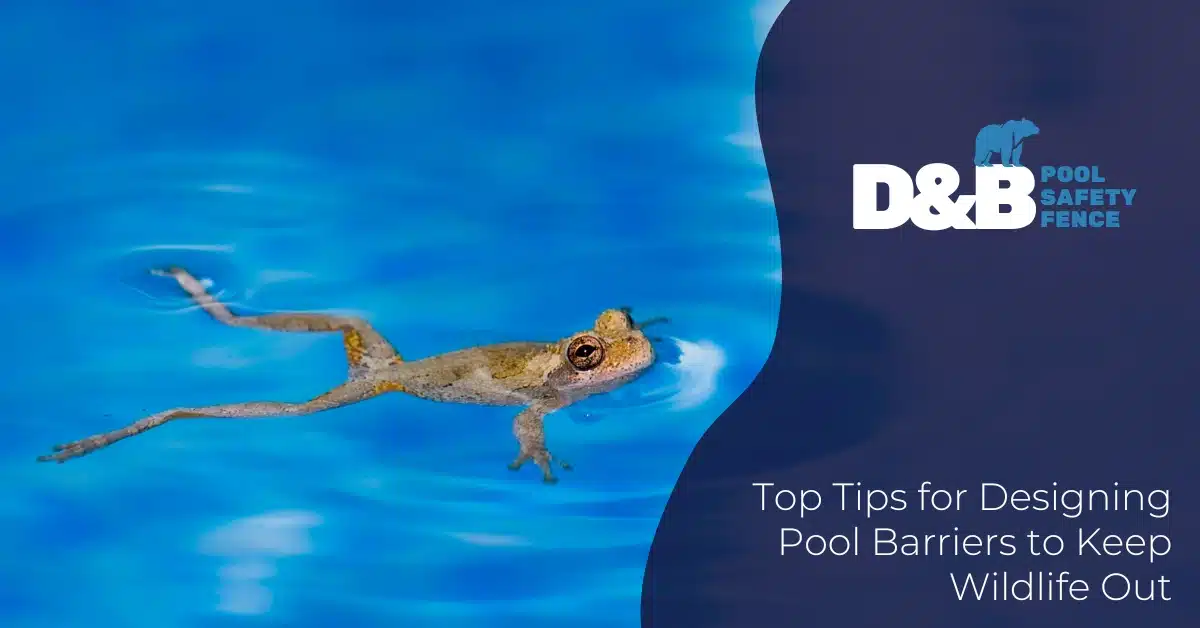Though we talk about human safety around pools often, we may forget that pet safety around pools is also crucial. Thousands of pets drown in swimming pools annually. Pets face higher drowning risks than humans. Pool areas pose dangers for pets. For example, pets can slip or fall into the water and be unsure of how to get out. So ensuring a safe pool environment for your pets is essential. Pet pool safety tips help protect your furry friends. In particular, fencing provides a barrier to keep pets safe. Pool fencing options offer various solutions for a variety of situations. Additionally, Monitoring pets near pools is vital. Pets enjoy playing outdoors and supervision ensures pets enjoy safely. Creating a safe pool area prevents accidents. Prioritizing pet safety keeps your pets safe and happy.
Pet Pool Safety Tips

Importance of Fencing for Pet Safety
Fencing plays a crucial role in ensuring the safety of pets around pools. Many pet owners overlook the potential hazards that a pool area can present. Pets, especially dogs and cats, may accidentally fall into the water. However, a well-installed fence acts as a barrier, preventing such incidents. Solutions exist, however, and the Arizona Pool Fence is one example of a reliable solution for pet safety. This type of fence provides peace of mind by keeping pets away from the pool area when unsupervised.
Types of Pet Fences
Pet fences come in various types to suit different needs and preferences for pool safety. Some popular options include:
- Mesh Fences: Lightweight and transparent, these fences allow you to see the pool area while keeping pets safe.
- Glass Fences: With a clean look, these provide a clear view and add aesthetic value to the backyard without compromising security.
- Removable Fences: Perfect for temporary setups, these fences can be easily installed and removed as needed.
As you can see, each type offers unique benefits, making it essential to choose one that fits your specific requirements.
Benefits of Installing Fences
Installing fences around your pool area offers numerous benefits. Fences prevent pets from accessing the pool when you are not around. This especially reduces the risk of accidental drowning. Fences also help in defining the pool area, creating a safe space for pets to play in the backyard. Additionally, fences enhance the overall appearance of the backyard, providing a neat and organized look.
Choosing the Right Fence
Selecting the right fence involves considering several factors. To start you need to assess the size and layout of your backyard. Then keep in mind, the material of the fence should be durable and weather-resistant. Additionally, consider the height of the fence to ensure it effectively prevents pets from jumping over. The design should complement the aesthetics of your backyard. Consulting with professionals can help in making an informed decision. They can provide insights into the best fencing solutions for your specific needs.
Pool Fencing Options

Install Pool Fencing Options for Pets
Permanent Pool Fencing Solutions
Permanent pool fencing solutions provide a long-lasting way to protect pets. Many homeowners choose materials like resin, wood, chainlink, or wrought-iron for their durability. These fences loop around the pool area and feature a locking gate to prevent unauthorized access. A permanent fence offers peace of mind by ensuring that pets cannot wander into the pool area unsupervised. The installation process involves securing the fence into the ground, which guarantees stability and effectiveness.
Temporary Fencing Solutions
Temporary fencing solutions offer flexibility for pet owners who may not need a permanent structure. Folding gates and removable fences are popular choices. These options allow you to install pet fences quickly and remove them when not needed. Temporary fences are ideal for renters or those who want a seasonal solution. Mesh pool fencing stands out as a practical choice due to its lightweight nature and ease of installation. This type of fence provides safety without compromising the view of the pool area.
Additional Safety Features
Pool Covers and Alarms
Pool covers serve as an additional layer of protection for pets. A sturdy cover prevents pets from accidentally falling into the water. Different types of covers, such as solid and mesh, cater to various needs. Pool alarms enhance safety by alerting you if a pet enters the pool area. These devices detect movement in the water and sound an alarm, providing an immediate warning. Combining covers with alarms creates a comprehensive safety system for your pool.
Door Systems and Gates
Door systems and gates add another level of security to your pool area. Installing self-closing and self-latching gates ensures that pets cannot easily access the pool. These gates automatically close behind you, reducing the chance of leaving them open accidentally. Door systems can include alarms that activate when someone opens the door leading to the pool. This feature helps you monitor access to the pool area and keeps pets safe.
Monitoring and Supervision
Pet Pool Safety Tips: Keeping a Close Eye
Importance of Supervision
Supervision plays a crucial role in keeping pets safe around water. Pet owners must always remain vigilant when pets are near the pool. Accidents can happen quickly, and constant supervision helps prevent them. Owners should never leave dogs unattended by the poolside. A watchful eye ensures that pets do not wander into unsafe areas. Supervision also allows owners to intervene if dogs show signs of distress. The presence of a family member can make a significant difference in preventing accidents.
Using Technology for Monitoring
Technology offers great options for monitoring pets around pools. Smart devices provide pet owners with tools to keep an eye on their furry friends. Wearable devices track a dog’s location and activity levels. These gadgets alert owners if a dog approaches the pool area. Door systems equipped with sensors notify owners when a door opens. This feature ensures that pets do not access the pool without supervision. Advanced systems analyze behavior changes, offering insights into a pet’s well-being. Technology serves as a valuable ally in maintaining safety.
Training Pets for Pool Safety
Teaching Commands
Training dogs with specific commands enhances pool safety. Commands like “stay” or “come” help control a dog’s movements. Consistent training reinforces these commands, making them effective. Pet owners should practice commands regularly to ensure obedience. Positive reinforcement encourages dogs to respond correctly. Training sessions should occur in a calm environment, free from distractions. A well-trained dog listens to commands, reducing the risk of accidents.
Familiarizing Pets with Water
Introducing pets to water gradually helps them feel comfortable. For example, owners should allow dogs to explore shallow areas first. This approach builds confidence and reduces fear. Encouragement and praise motivate pets to enjoy the water. Familiarity with water decreases the likelihood of panic during accidental falls. Owners should supervise these sessions to ensure safety. A positive experience with water creates a safe environment for the entire family.
Additional Safety Tips
Emergency Preparedness
First Aid for Pets
Pet owners should learn basic first aid techniques to handle emergencies. Quick and effective action can save a pet’s life. You should keep a pet first aid kit near the pool area. The kit should include items like bandages, antiseptic wipes, and a pet-safe thermometer. Knowing how to perform CPR on pets is crucial. You can find resources online or attend local workshops to learn these skills. Ohio has laws allowing first responders to provide lifesaving aid to pets. This emphasizes the importance of being prepared for emergencies.
Contacting Emergency Services
You should have contact information for local emergency services readily available. Keep numbers for veterinarians and animal hospitals in an easily accessible location. Time is critical during emergencies. Quick access to these contacts can make a significant difference. You should inform family members or anyone supervising the pool about these emergency contacts. Make sure everyone knows the steps to take if an incident occurs. Being prepared ensures that you can act swiftly and effectively to protect your pets.
Prioritizing pet safety around pools ensures a secure environment for your furry friends. Key safety measures include installing reliable fencing and maintaining constant supervision. Fencing acts as a crucial barrier, preventing pets from accessing the pool unsupervised. Monitoring tools and training enhance safety by keeping pets away from potential hazards. Implementing these strategies creates layers of protection, reducing the risk of accidents. Take action today to safeguard your pets. Invest in effective fencing and monitoring solutions. Ensure a safe and enjoyable pool experience for everyone.






